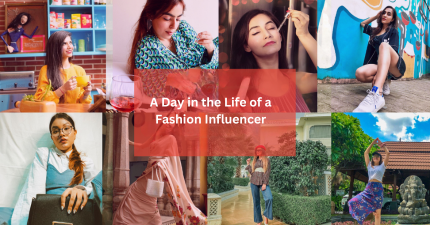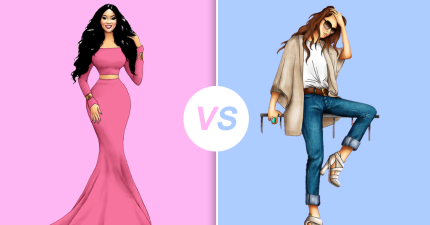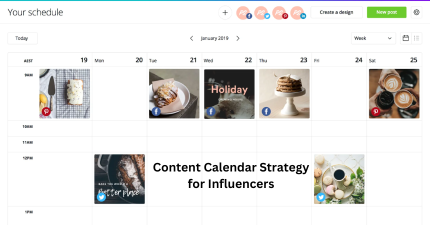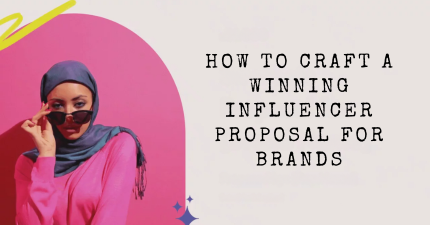
- 03 Nov, 2024
Crafting Your Success: A Step-by-Step Guide to Building a Professional Influencer Media Kit
In the digital landscape, becoming a successful influencer is more than just posting eye-catching photos or sharing captivating stories; it's about showcasing your unique brand and establishing credibility in an ever-crowded marketplace. Enter the media kit—a powerful tool that serves as your portfolio, resume, and business card all rolled into one. Whether you're a seasoned content creator or just starting on your influencer journey, crafting a professional media kit can set you apart from the competition and open doors to exciting partnerships. Imagine being able to effortlessly present your story, audience insights, and collaboration potential—all packaged beautifully for brands looking for their next big ambassador. In this step-by-step guide, we'll walk you through everything you need to know about building an impactful media kit that not only highlights your strengths but also resonates with potential partners. Get ready to elevate your influencer game and pave the way for success—let’s dive in!
Introduction: The Importance of a Media Kit for Influencers
In the rapidly evolving world of social media, standing out as an influencer can feel daunting. With countless creators vying for attention, having a professional media kit is essential to showcase your unique brand and attract potential partnerships. Think of it as your digital resume—it highlights your strengths, achievements, and what you bring to the table. Just like a well-crafted pitch can open doors in any industry, a polished media kit can help you land collaborations that align with your vision.
But what exactly goes into creating one? Whether you're just starting or looking to refine your existing kit, this step-by-step guide will walk you through the process. Get ready to elevate your influence and craft a compelling narrative that resonates with brands and followers alike. Your journey toward success begins here!
What is an Influencer Media Kit?
An influencer media kit is essentially a marketing tool. It acts as a snapshot of who you are and what you offer.
This document showcases your brand, audience demographics, and engagement metrics. It's designed to attract potential partnerships with brands or businesses looking for influencers like you.
Typically, it includes high-quality images, testimonials, and details about past collaborations. Brands want to see not just numbers but the story behind them.
Your media kit should reflect your unique style while providing essential information in an organized manner. This makes it easy for companies to understand how they can work with you effectively.
Think of it as a professional introduction that highlights your value in the digital space. A well-crafted media kit sets the stage for fruitful collaborations and lasting relationships within the industry.
Why Do You Need an Influencer Media Kit?
An influencer media kit is your passport to collaboration and opportunities. It serves as a professional introduction that showcases who you are and what you offer.
Brands receive numerous pitches daily. A well-crafted media kit helps you stand out from the crowd. It visually represents your brand identity while conveying essential information concisely.
Having this tool builds credibility. When potential partners see a polished media kit, they perceive you as serious and organized, increasing their trust in your abilities.
It also simplifies communication. Instead of repetitive emails outlining your stats or past work, everything is neatly packaged. This efficiency can lead to quicker responses and more fruitful discussions.
Ultimately, a media kit enhances professionalism in an ever-expanding influencer landscape. It's not just about showcasing numbers; it's about crafting an engaging narrative that resonates with brands seeking authentic connections.
Step 1: Identify Your Target Audience and Niche
Identifying your target audience is crucial. It’s the first step in creating a media kit that resonates with potential collaborators and brands. Start by understanding who engages with your content.
Think about their demographics—age, gender, location—and interests. Are they fitness enthusiasts? Fashion lovers? Tech geeks? Knowing this helps tailor your messaging.
Next, define your niche clearly. A specific focus sets you apart from others. Instead of just being a lifestyle influencer, you could specialize in eco-friendly living or sustainable fashion.
Research competitors within your niche as well. This analysis reveals gaps in the market and opportunities for collaboration.
Consider engaging directly with your followers through polls or questions on social media platforms to gather insights into what they value most from influencers like you.
This foundational work will guide every aspect of your media kit moving forward.
Step 2: Define Your Brand and Personal Style
Defining your brand and personal style is crucial for standing out in the crowded influencer landscape. Your brand represents who you are, what you stand for, and how you connect with your audience. Think about the values that resonate with you. Is it authenticity, creativity, or empowerment?
Next, consider your visual identity. This includes everything from color schemes to fonts and imagery choices. Consistency is key here; it helps people recognize your content at a glance.
Don’t forget about tone! Whether you're humorous, informative, or inspirational, make sure it's reflected across all platforms. Your unique voice will draw followers in and create lasting connections.
Finally, think about the stories behind your posts. Sharing personal experiences can enhance relatability while reinforcing your brand’s core message.
Step 3: Gather Your Statistics and Metrics
Your statistics and metrics are the backbone of your media kit. They provide tangible evidence of your influence and reach. Start by collecting follower counts across all platforms. This includes Instagram, TikTok, Twitter, and any others where you engage with your audience.
Engagement rates are just as crucial. Track likes, comments, shares, and saves to showcase how actively your followers interact with your content. Brands want to know that their message will resonate.
Consider including website or blog traffic stats if applicable. These figures tell potential partners about the volume of visitors engaging with your content outside social media.
Don’t forget demographics! Knowing who makes up your audience can help brands see if you're a good fit for their target market. Gather insights on age groups, locations, and interests—anything that paints a clearer picture of who follows you enhances credibility in discussions with clients.
Step 4: Showcase Your Best Content and Collaborations
Your media kit should reflect the essence of your work. Highlighting your best content is crucial. Choose pieces that resonate with your audience and showcase your unique style.
Select projects that led to significant engagement or positive feedback. This demonstrates not just creativity but also impact. Include images, videos, or links that represent your brand effectively.
Collaborations are equally important. They show you've worked with others in the industry and can build relationships. Showcase partnerships with brands you admire and outline the outcomes of these projects.
Consider incorporating testimonials from collaborators as well. These endorsements add credibility to your profile and illustrate how you’ve made a difference in previous campaigns.
Your chosen works should tell a story about who you are as an influencer while captivating potential partners’ interest without overwhelming them.
Step 5: Highlight Your Services and Rates
Highlighting your services and rates is crucial for potential clients. This section should be clear and concise.
Begin by listing the different types of collaborations you offer. Whether it’s sponsored posts, product reviews, or social media takeovers, make sure to specify each service.
Transparency is key when discussing rates. Consider providing a range or starting prices to give prospective partners an idea of what to expect. If your pricing varies based on factors like project scope or audience engagement, mention that too.
Use straightforward language; avoid jargon that might confuse non-industry folks. You want everyone who reads your kit to understand exactly what you provide and how they can benefit from working with you.
Adding a call-to-action here can also be effective—invite them to reach out for custom quotes tailored to their needs.
Step 6: Designing Your Media Kit
Designing your media kit is a vital step that showcases your brand's personality. A polished presentation can capture attention and convey professionalism.
Start with a clean layout. Use ample white space to avoid overwhelming the reader. Consistency in fonts, colors, and graphics creates harmony throughout the document.
Visuals matter. Incorporate high-quality images of yourself and any branded content. This not only makes it visually appealing but also personalizes your kit, helping potential collaborators connect with you.
Consider including infographics or charts to illustrate key statistics and metrics clearly. A well-placed graphic can communicate complex information quickly.
For those looking for tools, platforms like Canva or Adobe Spark offer user-friendly templates tailored for media kits. These resources simplify design while ensuring a professional look without needing extensive graphic design skills.
Tips for Creating a Professional Design
When designing your influencer media kit, simplicity is key. Opt for a clean layout that allows your content to shine. Avoid overcrowding pages with text or images; white space can enhance readability and appeal.
Choose a color palette that reflects your brand’s personality. Consistent colors create a cohesive look throughout the document. Stick to two or three main colors to avoid overwhelming potential partners.
Fonts play an essential role as well. Select easy-to-read fonts for body text while reserving decorative styles for headings. This creates visual interest without sacrificing clarity.
Images should be high-quality and relevant to your niche. Use professional photos of yourself alongside samples of previous work or collaborations, showcasing what you bring to the table.
Finally, ensure everything aligns with your style—this media kit is truly an extension of you! Keep it authentic and engaging so that it resonates with those viewing it.
Tools and Resources for Designing Your Media Kit
Creating a visually appealing media kit is crucial for making a strong impression. A variety of tools can help you design something that stands out.
Canva is a popular choice, offering user-friendly templates tailored for social media influencers. You can easily customize colors, fonts, and layouts to fit your brand.
Adobe Spark also provides great flexibility, allowing for rich graphics and animations. If you're looking to create an engaging digital experience, this could be the tool for you.
For those who prefer more advanced options, Adobe InDesign offers professional-grade capabilities. It requires some learning but pays off with stunning results.
Don’t forget about resources like Unsplash or Pexels for high-quality images. Using eye-catching visuals can elevate your media kit significantly.
Step 7: Putting It All Together
With all your elements compiled, it’s time to package your media kit. A clean, organized layout is essential. Consider the flow of information and ensure each section transitions smoothly into the next.
Digital formats are popular for ease of use. Create a PDF version that’s easy to share via email or social media platforms. Ensure it's mobile-friendly; many recipients will view it on their phones.
If you’re opting for a physical kit, choose high-quality paper and professional binding. Include eye-catching visuals that reflect your brand identity.
When sending out your media kit, personalize each message. Tailor your introduction based on the recipient's interests or past collaborations with influencers in similar niches.
Follow up politely if you don’t receive a response within a week or two. Persistence can pay off when building relationships in this competitive space.
Packaging Your Media Kit
Packaging your media kit is about making a lasting impression. Start by choosing the right format—digital or physical, depending on your audience's preferences.
For digital kits, consider using PDF files for easy sharing and accessibility. A well-organized file with clickable links can enhance user experience. Make sure to name your file clearly, ideally using your brand name.
If you opt for a physical media kit, choose high-quality materials that reflect your brand’s aesthetic. Use sturdy folders or custom boxes that feel professional in hand.
Adding personal touches can set you apart; handwritten notes or unique branding elements create a connection.
Remember to include clear instructions on how recipients can reach out for collaborations or inquiries within the package itself. This encourages immediate engagement and shows professionalism from the start.
Sending Out Your Media Kit
Once you’ve compiled and designed your media kit, it’s time to share it with the world. Start by packaging your media kit to reflect your brand's personality. Consider creating both digital and print versions. A well-designed PDF can easily be emailed, while a printed version might make an impactful statement during face-to-face meetings.
When sending out your media kit, personalize each communication. Address recipients by name and explain why you believe they would benefit from collaborating with you. This personal touch makes connections more meaningful.
Follow up after sending out your media kit if you haven't heard back within a week or two. Persistence shows enthusiasm but balances this with respect for their time.
Remember, your media kit is not just a document; it’s an extension of who you are as an influencer. It opens doors to collaborations and partnerships that align with your vision and values—so put thought into every detail before hitting send!




